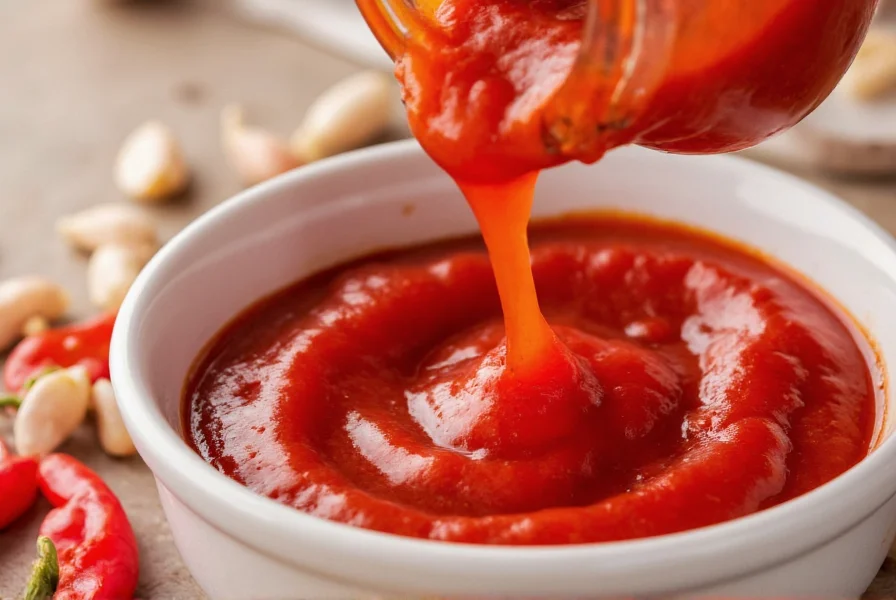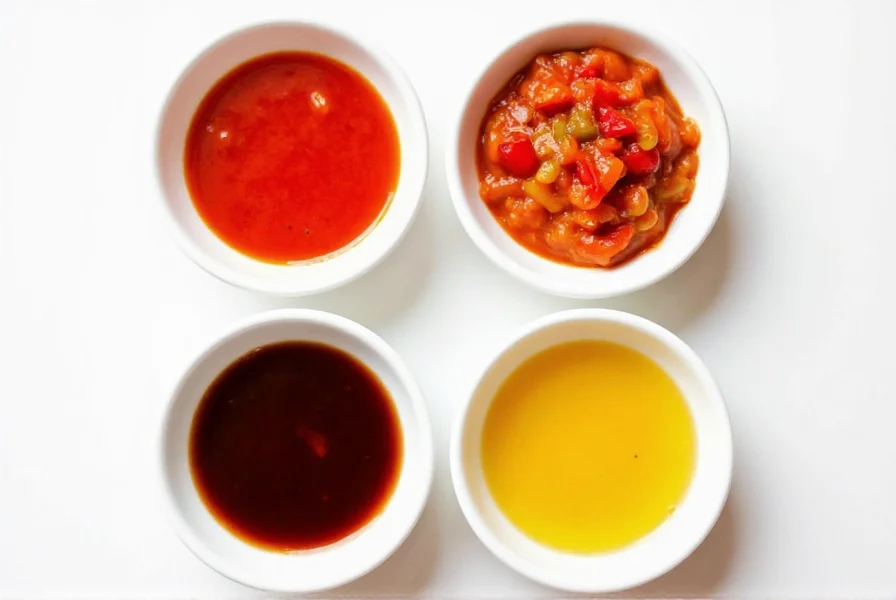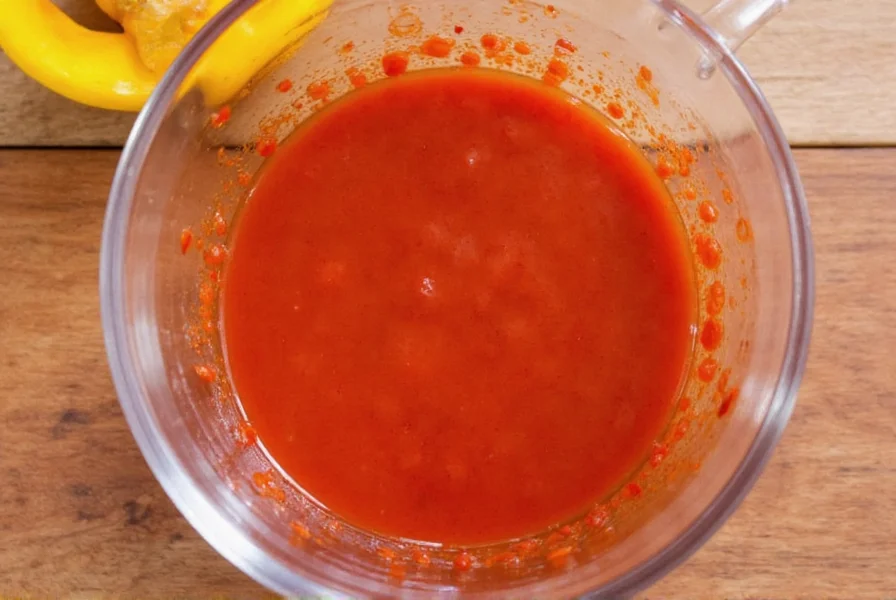Here's a proven homemade chili sauce recipe that yields a balanced, flavorful sauce in just 30 minutes: Combine 1 cup fresh red chilies (seeds removed for milder taste), 3 garlic cloves, 1/4 cup vinegar, 2 tbsp sugar, 1 tsp salt, and 1/2 cup water in a blender. Blend until smooth, then simmer for 15 minutes until thickened. Cool before storing in airtight containers. This authentic chili sauce recipe makes approximately 1.5 cups and can be customized for heat level and flavor profile.
Creating the perfect chili sauce requires understanding the balance between heat, acidity, and sweetness. Many store-bought versions contain preservatives and artificial flavors that compromise authentic taste. This homemade chili sauce recipe delivers vibrant flavor while allowing complete control over ingredients and spice level. Whether you're using it as a dipping sauce, stir-fry base, or condiment, this versatile recipe adapts to various culinary applications.
The Science Behind Great Chili Sauce
What separates exceptional chili sauce from ordinary versions lies in the chemical interactions between ingredients. The capsaicin in chilies binds with fats and acids, which is why vinegar plays a crucial role in both preservation and flavor development. Sugar doesn't just add sweetness—it counterbalances acidity and helps caramelize flavors during cooking. The emulsification process that occurs when blending creates a smooth texture that store-bought sauces often lack due to stabilizers.
Ingredient Selection Guide
Choosing quality ingredients makes the difference between good and exceptional chili sauce:
| Ingredient | Recommended Type | Substitution Options | Function |
|---|---|---|---|
| Chilies | Fresh red jalapeños or serranos | Dried chilies (soaked), chili flakes | Heat source and primary flavor |
| Acid | Apple cider vinegar | Rice vinegar, lime juice | Brightness and preservation |
| Sweetener | Raw cane sugar | Honey, maple syrup | Balance and caramelization |
| Garlic | Fresh cloves | 1/2 tsp garlic powder | Depth and complexity |
For authentic chili sauce ingredients, seek out locally grown chilies when possible—they'll have superior flavor compared to shipped varieties. The ripeness of chilies significantly impacts heat level; fully red chilies tend to be sweeter and less intensely hot than green ones.
Step-by-Step Preparation
Follow these precise steps for consistent results every time you make chili sauce from scratch:
- Prepare 1 cup fresh red chilies by removing stems and seeds (wear gloves if sensitive to capsaicin)
- Peel and roughly chop 3 garlic cloves
- In a blender, combine chilies, garlic, 1/4 cup vinegar, 2 tbsp sugar, 1 tsp salt, and 1/2 cup water
- Blend on high for 1-2 minutes until completely smooth
- Pour mixture into a non-reactive saucepan
- Simmer over medium-low heat for 12-15 minutes, stirring occasionally
- Cool completely before transferring to storage containers

Avoiding Common Preparation Mistakes
Many home cooks encounter issues when making chili sauce without understanding these critical points:
- Over-blending: Excessive blending incorporates too much air, causing separation. Blend just until smooth.
- Incorrect heat level: High heat burns sugars and creates bitter flavors. Always use medium-low heat for simmering.
- Improper storage: Without adequate acidity (pH below 4.6), homemade sauces can spoil. Ensure proper vinegar ratio.
- Skipping the resting period: Flavors meld and improve after 24 hours of refrigeration.
Storage and Shelf Life Guidelines
Properly stored, this homemade chili sauce recipe maintains quality for different durations depending on method:
- Refrigeration: Store in airtight glass containers for up to 3 weeks
- Freezing: Portion into ice cube trays, then transfer to freezer bags for up to 6 months
- Water bath canning: Process sealed jars for 15 minutes for shelf-stable storage up to 1 year
Always use clean utensils when handling stored sauce to prevent contamination. The sauce may separate slightly during storage—simply shake or stir before use.
Variations for Different Culinary Applications
Customize this base recipe for specific uses with these professional adjustments:
- Mild version for kids: Replace half the chilies with red bell peppers and increase sugar to 3 tbsp
- Asian-inspired chili sauce: Add 1 tbsp grated ginger and 1 tsp sesame oil during simmering
- Smoky chipotle variation: Substitute 1/3 cup of fresh chilies with 2 rehydrated chipotle peppers in adobo
- Vinegar-free option: Use 1/4 cup lemon juice and add 1/2 tsp citric acid for proper preservation

Serving Suggestions and Pairings
This versatile sauce enhances numerous dishes when used appropriately:
- As a dipping sauce for spring rolls, dumplings, or grilled meats
- Stirred into soups and stews for instant flavor boost
- Marinated with proteins before grilling or roasting
- Thinned with vinegar for salad dressings
- Mixed with mayonnaise for sandwich spreads
Professional chefs often create compound sauces by blending this base with complementary ingredients like mango puree for tropical dishes or miso paste for umami-rich applications. The key is maintaining the 3:1 ratio of base sauce to additional ingredients to preserve the essential chili flavor profile.
Frequently Asked Questions
How can I reduce the heat level in homemade chili sauce without losing flavor?
Remove all seeds and white membranes from chilies, which contain most capsaicin. For significant heat reduction, replace half the chilies with red bell peppers while maintaining the same total volume. Adding 1-2 tbsp of roasted peanut butter introduces richness that counterbalances heat without altering the fundamental flavor profile of your authentic chili sauce.
Why does my homemade chili sauce separate after storage?
Separation occurs when the emulsion breaks, typically from insufficient blending or improper acid-to-oil ratio. To prevent this, ensure thorough blending until completely smooth and maintain the proper vinegar ratio (minimum 20% of liquid content). Adding 1/4 tsp xanthan gum during blending creates a stable emulsion for your chili sauce without vinegar alternatives while preserving texture.
Can I use dried chilies instead of fresh ones in this recipe?
Absolutely. Use 1/4 cup dried chilies (like arbol or guajillo) soaked in hot water for 20 minutes until soft. The resulting sauce will have deeper, more complex flavors but slightly different heat characteristics. When making chili sauce from scratch with dried chilies, reduce added water by half since rehydrated chilies release more liquid during blending.
How do I know if my homemade chili sauce has gone bad?
Signs of spoilage include mold growth, unpleasant sour or fermented smell (beyond the normal vinegar tang), bubbling, or significant color change. Properly made and stored chili sauce should maintain its vibrant red color. If in doubt, discard the sauce—homemade condiments don't have the preservatives of commercial products, so safety should always come first with your homemade chili sauce recipe.
What's the best way to adjust thickness in chili sauce?
To thicken, continue simmering uncovered while stirring frequently. For quick thickening, mix 1 tsp cornstarch with 1 tbsp cold water and stir into simmering sauce. To thin, add water or vinegar one tablespoon at a time until desired consistency. Remember that chili sauce thickens slightly as it cools, so test consistency at room temperature when perfecting your easy homemade chili sauce recipe.











 浙公网安备
33010002000092号
浙公网安备
33010002000092号 浙B2-20120091-4
浙B2-20120091-4